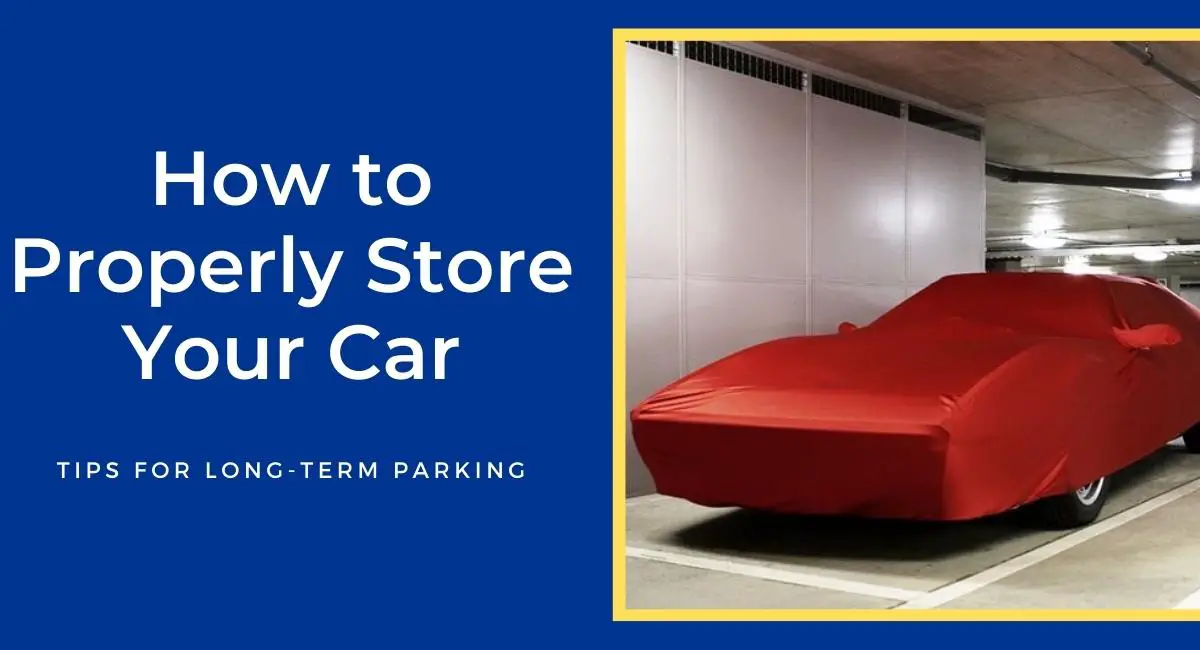We’ve all been there – that sinking feeling when you finally return to your car after a prolonged break, only to discover it needs more tender loving care than expected. Whether it’s been sitting idle during an extended vacation or patiently waiting for you to settle into a new home, an unused car can sometimes lead to unexpected trips to the mechanic.
But fear not! You can avoid the frustration and the hefty servicing bill with the proper steps. So, let’s dive into some tried-and-true tips on storing your car correctly, ensuring it’s ready to roll without a hitch when you decide it’s time to hit the road again.
Say goodbye to unnecessary garage drama and hello to a well-preserved, hassle-free driving experience! In this in-depth guide, we’ll explore every facet of how to store your car for an extended period, ensuring that it emerges from its hiatus as good as new.
Before anything else,
How Long Should You Store Your Car?
As you give your car a little break from the hustle and bustle of the road, the burning question is: How long is too long for your vehicle to be in storage? Let’s chat about that.
First off, there’s no one-size-fits-all answer here. The ideal storage duration depends on a few factors, like how well you’ve prepped your car and the conditions it’ll be facing. However, as a general rule of thumb, many experts suggest checking on your parked pal every three to six months.
Why the regular check-ins, you ask? Cars are like that friend who always needs a bit of attention. Therefore, you must find a way to visit regularly to allow you to start the engine, roll the tires, and ensure everything is ticking smoothly.
If you’re planning an extended break—think a year or more – you might want to consider some extra precautions. That’s when it’s wise to invest in a good quality car cover, maybe even throw in a fuel stabilizer to keep things in the tank from turning into a gunky mess.
Now, you’re still not off the hook if you’re just parking your ride for a short stint – a few weeks to a few months. Cars aren’t big fans of idleness, and things like the battery might decide to throw a tantrum if they’re left alone for too long.
No need to panic! A simple solution is having a friend or neighbor start your car occasionally. It’s like a wake-up call, reminding your vehicle that it’s still remembered.
In the end, the key is to strike a balance. You don’t want to check on your car every other day – it’s not a needy pet. But giving it some attention every few months ensures it stays in good spirits and is ready to hit the road when you are.
So, whether your car is taking a short nap or settling in for an extended siesta, remember you’ll need a few tips to keep it reliable. Check out the tips below to have it in perfect working condition.

Tips for Long-Term Packing
It is essential to master the art of long-term packing for your vehicle’s well-being. This guide explores important tips for preserving your four-wheeled companion and getting ready to hit the road when you decide to unveil it. Here are the key strategies for successfully packing your car long-term.
Selecting an Appropriate Storage Location
Choosing the right storage location is the first crucial step in the long-term parking process. Consider whether covered or uncovered parking is more suitable for your needs. Covered spaces provide additional protection from the elements, guarding against sun damage and extreme weather conditions. However, if covered storage isn’t available, look for outdoor spaces with climate control options.
Climate considerations are paramount when deciding where to park your vehicle. Intense hot or cold temperatures can negatively affect your car’s condition. Opt for a climate-controlled storage facility to shield your vehicle from temperature extremes if possible. Additionally, prioritize security features such as surveillance, secure access, and on-site personnel to deter theft or vandalism.
Cleaning and Preparing Your Car
Before tucking your car away, thoroughly clean it to prevent long-term damage. Start with the outside by washing and waxing to create a shield against environmental contaminants. Pay special attention to areas prone to rust, such as the undercarriage, and apply a rust protection treatment.
Moving to the interior, vacuum the floors and seats to remove any debris that might attract pests during storage. Consider using an interior cleaner to freshen up the cabin and eliminate odors. Cleaning both the exterior and interior not only preserves the aesthetics of your car but also contributes to a healthier, more pleasant driving experience when you eventually retrieve it.
To prevent the windshield wipers from sticking to the window screen, store the car with the wipers pulled away from the windshield or wrap them in plastic.
Mechanical Preparation
Taking care of your car’s mechanical components is essential for a smooth return to the road. Start by checking and topping off fluid levels, including engine oil, coolant, and brake fluid. Proper fluid levels ensure that vital components remain lubricated and protected against corrosion during the storage period.
Remember your tires. Inflate them to the recommended pressure and consider rotating them to prevent flat spots. Flat spots can occur when a car stays in one position for an extended period, leading to uneven tire wear.
Besides, slamming on the parking brake is usually a good move, but not when your car is on storage duty. Prolonged contact between brake pads and rotors can lead to fusion. Opt for a tire stopper, commonly known as a chock, to keep your vehicle in place without risking brake complications. Addressing these mechanical aspects sets the stage for a trouble-free return to driving when the time comes.
Battery Care
A dead battery is one of the most common issues with long-term car storage. To avoid this, disconnect the battery before parking your car. Alternatively, use a trickle charger to maintain a slow, steady charge—they are among the best car battery chargers today. Trickle chargers have a design that keeps the battery at an optimal level without overcharging. Regularly check the battery’s condition and recharge it as needed to ensure it’s ready for action when you decide to retrieve your vehicle.
Protecting Against Pests and Rodents
Cars in storage can become an attractive haven for pests and rodents seeking shelter. Seal any potential entry points, such as exhaust pipes and openings in the chassis, to keep unwanted guests out.
Additionally, use repellents like mothballs or electronic devices designed to deter rodents. Setting traps in strategic locations around the storage area provides an extra layer of protection. A little prevention goes a long way in preserving your car’s interior and preventing damage caused by gnawing critters.
Covering Your Car
Investing in a high-quality car cover is a wise decision for long-term storage. A car cover acts as a protective shield, safeguarding your vehicle from the elements. When choosing a cover, consider the material – opt for one that’s breathable to prevent moisture buildup, which can lead to mold and mildew.
Ensure a snug fit when installing the cover to prevent it from flapping in the wind, potentially causing scratches or damage to the paint. The right car cover shields your vehicle from the sun, rain, and snow, providing an extra defense against dust and airborne debris.
Regular Check-ups
Even when your car is in storage, it requires periodic check-ups to ensure everything remains in working order. Schedule regular inspections to catch potential issues early on. Start the engine periodically to circulate fluids and prevent components from seizing. During these short run sessions, engage the transmission and turn the steering wheel to maintain functionality.
If your car’s been chilling in one spot for too long, it can make the tires go all wonky with permanent flat spots. Nobody wants that! So, here’s the deal: consider giving your ride a little lift with jack stands. Check your car’s manual for the lowdown on how to do it right for your specific wheels. Save those tires from unnecessary drama!
Rolling the tires is another crucial step in preventing flat spots. Move the car forward or backward to change the tires’ contact points with the ground. This simple action helps distribute the weight evenly and minimizes the risk of flat spots, ensuring a smoother ride when you finally take your car back on the road.
Legal and Insurance Considerations
Before parking your car for an extended period, it’s essential to consider long-term storage’s legal and insurance aspects. Notify your insurance provider about your plans, as some policies offer discounts or options for temporarily suspending certain coverages during periods of non-use. Keep your vehicle compliant with local regulations to avoid issues regarding abandoned or unregistered vehicles.
Still, according to MarketWatch, insurance companies typically don’t provide specific policies tailored for stored cars. Yet, comprehensive coverage, designed to protect your vehicle in various non-moving situations, can serve as storage insurance.
For instance, while your car is in storage, you might encounter common concerns such as theft, vandalism, and exposure to natural disasters like flooding, fire, or severe weather conditions. Additionally, there’s the risk of damage to wiring or belts caused by rodent activity and the potential threat of falling objects, such as tree branches or items within a storage facility. Therefore, ideal insurance coverage for cars in extended storage is typically comprehensive and includes protection against all the mentioned risks.
Keep Your Engine Happy with Gasoline and Fuel Stabilizers
If your car runs on gasoline, it’s got a quirk – it loves to soak up moisture from the air. That might not sound like a big deal, but it can lead to funky business over a few months. The gasoline starts breaking down, causing trouble like rust in the fuel system and other engine hiccups. But fret not! Tossing a fuel stabilizer into your gas tank is like giving your car a superhero shield against all that drama. It keeps things smooth and the engine happy. Easy fix, right?
Retrieving Your Car
The moment has arrived to reunite with your car after its extended break. However, before hitting the road, a few steps are needed to ensure a smooth reactivation. Check fluid levels once again, reconnect the battery, and inspect the tires and brakes. Take your car for a short test drive to shake off the cobwebs and ensure everything works. It’s a small investment of time that pays off in the form of a trouble-free driving experience.
Conclusion
Properly storing your car long-term is more than just parking and remembering it. It’s a comprehensive process that involves careful consideration, preventive measures, and periodic check-ups. By following the tips in this guide, you can ensure that your car remains in an excellent state during its time in storage. When the day comes to unveil your vehicle and embark on new adventures, you’ll get a car that’s not only ready for the road but in perfect condition for the journey ahead. So, bid your car a temporary farewell with the confidence that you’ve done everything possible to keep it in top-notch condition during its hiatus. Cruising in a perfectly maintained car down the open road, your future self will undoubtedly thank you for your efforts.
